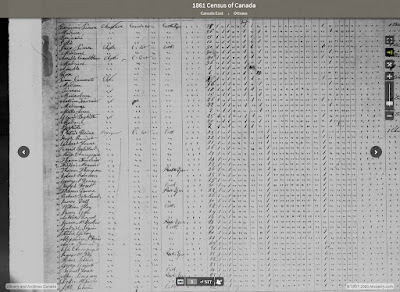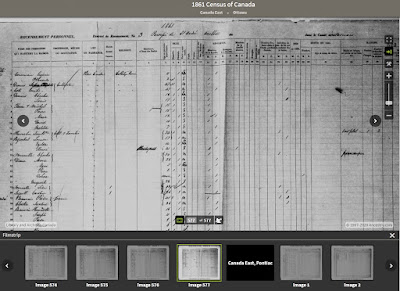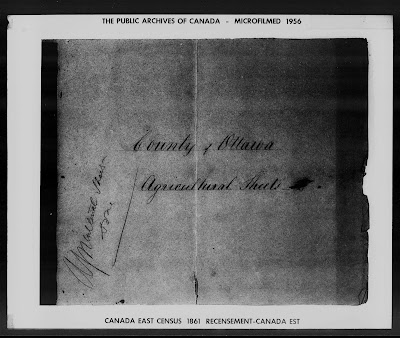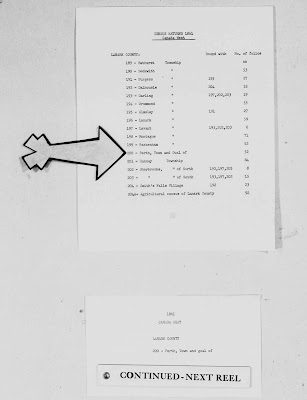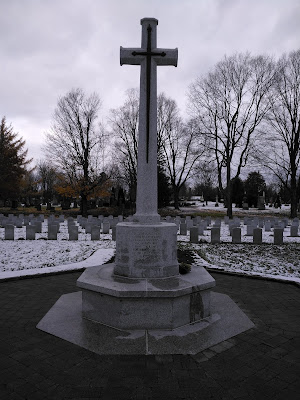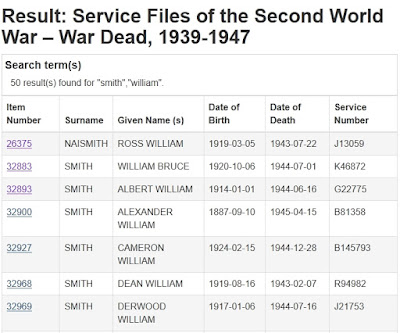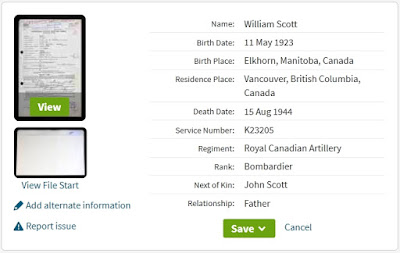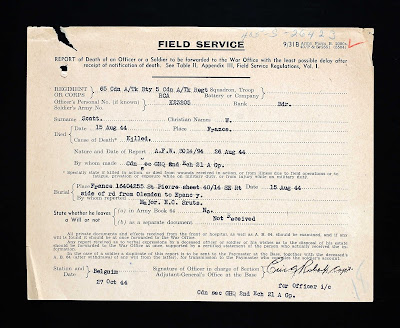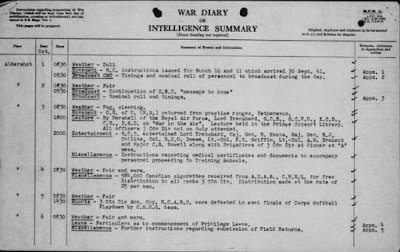Recently I came across this query in the United Empire Loyalists Association (UELAC) Facebook group and decided to see what I could find using just online resources since, with COVID-19 restrictions, brick and mortar archives and libraries are pretty much off limits. I'm also going to look at other sources of information to see what also can be uncovered.
My Orange County, New York ancestor John Darrington settled in May 1783 in King's County, New Brunswick. Does anyone know where I would find details of his 1787 claim to the British Government for his losses as a loyalist? There is a very helpful paragraph in Dubreau's New Brunswick Loyalists - a Bicentennial Tribute (1983), but Dubreau didn't cite any sources beyond a bibliography. I've purchased a copy of the most likely item in that bibliography but it came up short. Any recommendations appreciated.I took a look at Sharon M. Dubeau's book "New Brunswick Loyalists - a bicentennial tribute" published in 1983 by Generation Press to make sure no key details were missing from the query. The paragraph on John Darington does include the statement that he settled along the Kennebecasis River in Kings County along with the death of his wife, Joanna, in Portland (Saint John) in 1840 at the age of 95 years. What is interesting to me is that the New Brunswick Genealogical Society's "First Families" sources Dubeau's book for their entry but spells the name "Darlington".
For the various claims made by Loyalists we have to look at the Audit Office AO 12: American Loyalist Claims, Series I and AO 13: American Loyalist Claims, Series II to see if we can locate the documents. These are held by The National Archives in England but fortunately Library and Archives Canada have a microfilm copy of the files. Even better, LAC has had the microfilms digitized as part of the Héritage Project. The challenge for us is that AO 12 and AO 13 on the Héritage Project site aren't really indexed for searching. We can manually review the various pages in the microfilms but there is an easier way.
On Ancestry there is the "UK, American Loyalist Claims, 1776-1835" collection which has name indexed both AO 12 and AO 13.
A search of that collection returns three possible records:
 |
| Screen capture of Ancestry search results from the UK, American Loyalist Claims, 1776-1835 collection for John Darrington. |
There is also another challenge we face with the collection on Ancestry. When I viewed the first record the source citation stated:
The National Archives of the UK; Kew, Surrey, England; American Loyalist Claims, Series I; Class: AO 13; Piece: 025However, on the side of the image it states A.O.12 /25
| Screen capture from Ancestry image from UK, American Loyalist Claims, 1776-1835 collection for John Derington, Account of Losses. |
First I had to find volume 25 in AO 12. After a bit of jumping around in the images I found that it started on image 404 on microfilm C-12904. The index started on the next image and that is where I found John Derington listed.
 |
| Extract of index from AO 12/25 on Library and Archives Canada microfilm C-12904, image 405. |
Here is his claim for £209 and 12 shillings.
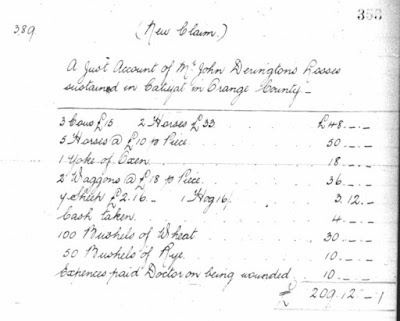 |
| Claim of John Derington, p 389, AO 12/25 Claims, American Loyalists - Series I, Evidence, New York, 1786-1787; citing Library and Archives Canada microfilm C-12904, image 757. |
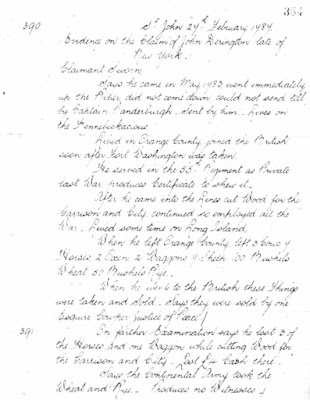 |
| Evidence for John Derington claim, p 389, AO 12/25 Claims, American Loyalists - Series I, Evidence, New York, 1786-1787; citing Library and Archives Canada microfilm C-12904, image 758. |
There is also the Minutes that Ancestry returned when we searched for John Darrington in the collection. Again, Ancestry's source citation references to AO 13/98 but, like the Account of Losses and Evidence, it is actually found in AO 12/98.
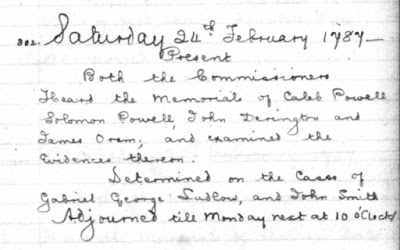 |
| Minutes pertaining to John Derington Memorial, p 302, AO 12/98 Claims, American Loyalists - Series I, Various, Minute Book, Halifax and Nova Scotia, 1785-1888; citing Library and Archives Canada microfilm C-12904, image 2020. |
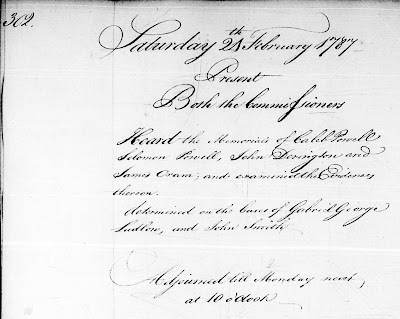 |
| Audit Office., AO12: American Loyalists Claims, Series I, Piece 098: Minute Book, Halifax and Nova Scotia, 1785-1788, p 302, minutes pertaining to John Derington. |
In Daniel F Johnson's New Brunswick Newspaper Vital Statistics we find the entry for the death announcement of Johanna Darington, the wife of John, from the January 29, 1840 edition of The New Brunswick Royal Gazette:
d. Thursday morn., Short Ferry, Portland (St. John) age 95, Johanna DARINGTON relict of John DARINGTON, Hampton (Kings Co.), one of the British Loyalists.For the surname Darrington there several records concerning land that are of possible interest:
Index to New Brunswick Land Grants, 1784 - 1997 (RS686)
| Name | DARRINGTON, John |
| Volume | NS-1 |
| Page | 9 |
| Grant number | 3 |
| Place | Kingston Township |
| County | Sunbury |
| Date | 1784-12-27 |
| Accompanying plan | Yes |
| Acres | 200 |
| Microfilm | F16300 |
| Comment | Re-registered NS Grant of 1784/07/15: Plan 150 Rs. *2/39 |
Index to Land Petitions: Original Series, 1783-1918 (RS108)
| Name | DARRINGTON, JOHN |
| Year | 1796 |
| County | Kings |
| Microfilm | F1039 |
Index to Land Petitions: Original Series, 1783-1918 (RS108)
| Name | DARRINGTON, JOHN |
| Year | 1798 |
| County | Kings |
| Microfilm | F1040 |
| See petition of | DICKIE, HECTOR |
The first record from RS686 is interesting since that is a re-register of a Nova Scotia grant. Just to refresh your memory, until August 16, 1784, New Brunswick was known as Sunbury County, Nova Scotia. We are fortunate that the Nova Scotia Archives has digitized the early land papers in their collection Nova Scotia Land Papers 1765-1800. Even better, the collection is name searchable!
There I found the image of the grant along with the surveyor's report and certificate, all available for download for free. This was a grant for a total of 4509 acres on the River Kennebeccasis in the Township of Kingston. County of Sunbury (now Kings County, New Brunswick) for 27 people.
What about those land petitions in RS108. I logged in to FamilySearch and looked at the catalogue for "Canada, New Brunswick" and came across an open set of digitized microfilms in the "Land petitions, 1783-1857" collection. Within the digitized microfilm "1793 Lee, Samuel - 1796 Knox, John" on DGS 8191398 (FHL 1288461) starting at image 738 I found the land petition from the New Brunswick microfilm F1039.
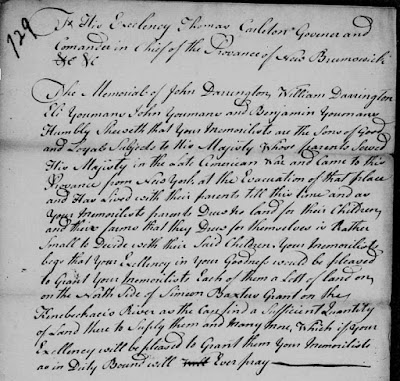 |
| Darrington, John et al, 1796; RS108, Land Petitions; Provincial Archives of New Brunswick, Fredericton; FHL microfilm 1,288,461, image 739. |
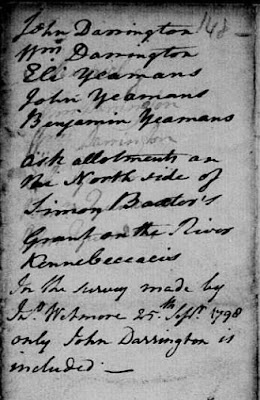 |
| Darrington, John et al, 1796; RS108, Land Petitions; Provincial Archives of New Brunswick, Fredericton; FHL microfilm 1,288,461, image 740. |
Yet another source of possible information concerning land, and even wills, are the Deed Registry Books for New Brunswick. In this case we want to check the New Brunswick, Kings County, deed registry books, 1785-1920; index, 1785-1992 also on FamilySearch.
 |
| "New Brunswick, County Deed Registry Books, 1780-1930," images, FamilySearch (https://familysearch.org/ark:/61903/3:1:S3HT-6S6X-WX?cc=1392378&wc=M69X-RM9%3A13841801%2C16555201%2C22610502 : 21 May 2014), Kings > Index book, grantor-grantee > 1785-1880, A-L > image 314 of 781; County Office of Service, New Brunswick, Canada. |
There is also Lorenzo Sabine's work "Biographical Sketches of Loyalists of the American Revolution, with an Historical Essay", published in 1864, where he records in volume I on page 359:
DARINGTON, JOHN. He emigrated to New Brunswick at the peace, and died there. Joanna, his widow, died in Portland, in that Province, in 1840, at the age of ninety-five.
Finally, if we look at the United Empire Loyalists' Association of Canada web site in the Loyalist Directory we find an entry for John Darrington that referenced NYGBS; V36 N1 Jan 1905. That translates to the New York Genealogical & Biographical Society Record, volume 36, number 1, January 1905. You can find a copy on the Internet Archive and on page 27 you will find the one line entry about him.
There are many other resources that can be examined but I think we have answered the query in full and then some.
I hope that this helps in your own research into the Loyalists that settled in what later became New Brunswick, Canada.
 Back in 2014 I wrote a post about
Back in 2014 I wrote a post about  Every once in a while the fine folks that handle the
Every once in a while the fine folks that handle the 
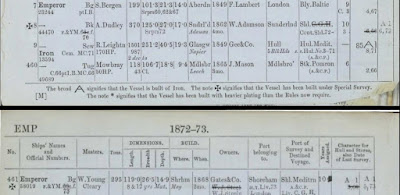


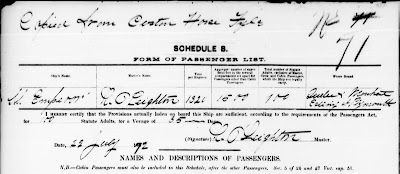
 Recently a genealogy researcher colleague of mine asked for some assistance in locating the agricultural schedule from the 1861 Census of Canada. This was her question to me:
Recently a genealogy researcher colleague of mine asked for some assistance in locating the agricultural schedule from the 1861 Census of Canada. This was her question to me: